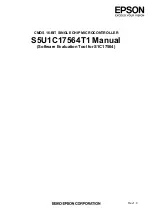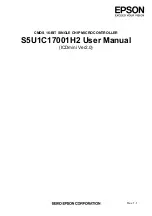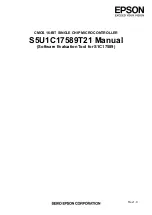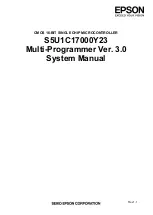C8051F120/1/2/3/4/5/6/7
Rev. 1.2
253
21.3. SPI0 Slave Mode Operation
When SPI0 is enabled and not configured as a master, it will operate as a SPI slave. As a slave, bytes are shifted in
through the MOSI pin and out through the MISO pin by a master device controlling the SCK signal. A bit counter in
the SPI0 logic counts SCK edges. When 8 bits have been shifted through the shift register, the SPIF flag is set to logic
1, and the byte is copied into the receive buffer. Data is read from the receive buffer by reading SPI0DAT. A slave
device cannot initiate transfers. Data to be transferred to the master device is pre-loaded into the shift register by writ-
ing to SPI0DAT. Writes to SPI0DAT are double-buffered, and are placed in the transmit buffer first. If the shift regis-
ter is empty, the contents of the transmit buffer will immediately be transferred into the shift register. When the shift
register already contains data, the SPI will load the shift register with the transmit buffer’s contents after the last SCK
edge of the next (or current) SPI transfer.
When configured as a slave, SPI0 can be configured for 4-wire or 3-wire operation. The default, 4-wire slave mode,
is active when NSSMD1 (SPI0CN.3) = 0 and NSSMD0 (SPI0CN.2) = 1. In 4-wire mode, the NSS signal is routed to
a port pin and configured as a digital input. SPI0 is enabled when NSS is logic 0, and disabled when NSS is logic 1.
The bit counter is reset on a falling edge of NSS. Note that the NSS signal must be driven low at least 2 system clocks
before the first active edge of SCK for each byte transfer. Figure 21.4 shows a connection diagram between two slave
devices in 4-wire slave mode and a master device.
3-wire slave mode is active when NSSMD1 (SPI0CN.3) = 0 and NSSMD0 (SPI0CN.2) = 0. NSS is not used in this
mode, and is not mapped to an external port pin through the crossbar. Since there is no way of uniquely addressing
the device in 3-wire slave mode, SPI0 must be the only slave device present on the bus. It is important to note that in
3-wire slave mode there is no external means of resetting the bit counter that determines when a full byte has been
received. The bit counter can only be reset by disabling and re-enabling SPI0 with the SPIEN bit. Figure 21.3 shows
a connection diagram between a slave device in 3-wire slave mode and a master device.
21.4. SPI0 Interrupt Sources
When SPI0 interrupts are enabled, the following four flags will generate an interrupt when they are set to logic 1:
Note that all of the following bits must be cleared by software.
1. The SPI Interrupt Flag, SPIF (SPI0CN.7) is set to logic 1 at the end of each byte transfer. This flag can
occur in all SPI0 modes.
2. The Write Collision Flag, WCOL (SPI0CN.6) is set to logic 1 if a write to SPI0DAT is attempted when
the transmit buffer has not been emptied to the SPI shift register. When this occurs, the write to SPI0DAT
will be ignored, and the transmit buffer will not be written.This flag can occur in all SPI0 modes.
3. The Mode Fault Flag MODF (SPI0CN.5) is set to logic 1 when SPI0 is configured as a master, and for
multi-master mode and the NSS pin is pulled low. When a Mode Fault occurs, the MSTEN and SPIEN bits
in SPI0CN are set to logic 0 to disable SPI0 and allow another master device to access the bus.
4. The Receive Overrun Flag RXOVRN (SPI0CN.4) is set to logic 1 when configured as a slave, and a
transfer is completed and the receive buffer still holds an unread byte from a previous transfer. The new byte
is not transferred to the receive buffer, allowing the previously received data byte to be read. The data byte
which caused the overrun is lost.
Summary of Contents for C8051F120
Page 2: ...C8051F120 1 2 3 4 5 6 7 2 Rev 1 2 Notes ...
Page 8: ...C8051F120 1 2 3 4 5 6 7 8 Rev 1 2 26 2 Flash Programming Commands 318 26 3 Debug Support 321 ...
Page 16: ...C8051F120 1 2 3 4 5 6 7 16 Rev 1 2 Notes ...
Page 48: ...C8051F120 1 2 3 4 5 6 7 48 Rev 1 2 ...
Page 98: ...C8051F120 1 2 3 4 5 6 7 98 Rev 1 2 ...
Page 106: ...C8051F120 1 2 3 4 5 6 7 106 Rev 1 2 Notes ...
Page 183: ...C8051F120 1 2 3 4 5 6 7 Rev 1 2 183 Notes ...
Page 184: ...C8051F120 1 2 3 4 5 6 7 184 Rev 1 2 ...
Page 214: ...C8051F120 1 2 3 4 5 6 7 214 Rev 1 2 Notes ...

















